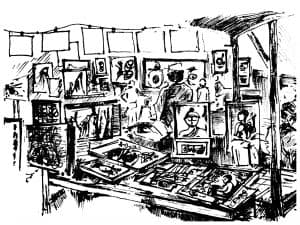The annual Chitra Santhe was held on 6th January 2020 in Bengaluru this year. Since 2003, the festival has been celebrating traditional and contemporary art and making it accessible to the public. It has brought art out of galleries and museums to the streets thereby reaching out to broader audiences. The art fair featured over 1,300 artists this year and is estimated to have had around four lakh visitors. For more details, see Yourstory. Artists from outside Bangalore – North Karnataka, Goa, Odissa, West Bengal, Tamil Nadu and Kerala participate.
The Kumara Krupa Road leading up to the Karnataka Chitrakala Parishath or CKP has been the standard venue for the Chitra Sante since its inception. The street is strictly pedestrian only for the entire day and vehicular traffic is diverted through race course to Sankey road from Shivananda Circle. On the street are spread out art of all shapes, sizes, mediums and themes. Street vendors are found selling snacks and other items such as balloons, bubbles, toys and so on.
This is an example of a deliberate urban space creation inviting a user group of art lovers and investors from all classes of society. The BBMP arranges mobile toilets and garbage bins at regular intervals. The Kumara Krupa road being full of trees becomes an obvious choice to display street art utilizing shade beneficially. The bus shelters, the amphitheatre at the Chitra Kala Parishad campus and the footpaths are converted spaces with strings running along to hang canvases or art while pedestrians walk in-between. For details, see The Hindu.
 Some artists keep their stall minimally decorated, a few add in frills under the tree canopies and others set up a simple base around the bus shelters. An artist may set up a 8 x 8 stall that has a display of his paintings and position himself on a chair nearby so as to speak directly to his customers. Live portrait artists are seen working on portraits oblivious to the noise around them. Sometimes, an artist has a helper who runs the errands of the business from behind the painting display. It is interesting to note how pause points are created between functions of engaging in art and indulging in food as people enjoy their Sunday outing here.
Some artists keep their stall minimally decorated, a few add in frills under the tree canopies and others set up a simple base around the bus shelters. An artist may set up a 8 x 8 stall that has a display of his paintings and position himself on a chair nearby so as to speak directly to his customers. Live portrait artists are seen working on portraits oblivious to the noise around them. Sometimes, an artist has a helper who runs the errands of the business from behind the painting display. It is interesting to note how pause points are created between functions of engaging in art and indulging in food as people enjoy their Sunday outing here.
There is so much to ponder about, of all the urban elements that create and and engage us in this Chitra Santhe – who comes here, what do they give to it, what do they take from it? How do urban spaces in the city lend themselves to our social and cultural needs? How does pedestrianisation of a street become possible in Bangalore? How does it work elsewhere? Perhaps, there is so much to learn about people and cities through simply walking our streets.
[This is a guest post by Manasa Vinodkumar who is currently a research associate at the Everyday City Lab]